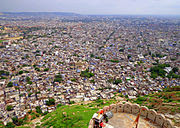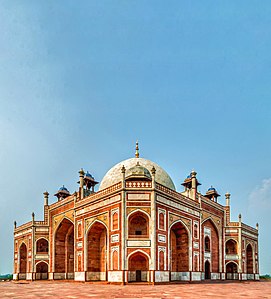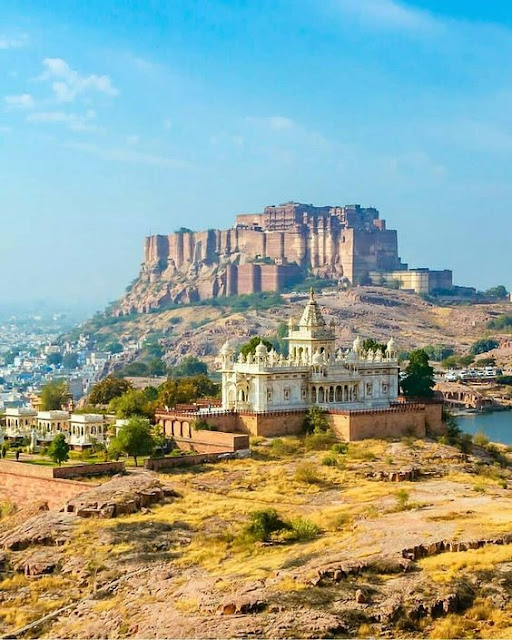Jaipur city from Nahargarh Fort
Nahargarh Fort
 Nahargarh Fort stands on the edge of the Aravalli Hills, overlooking the city of Jaipur in the Indian state of Rajasthan. Along with Amer Fort and Jaigarh Fort, Nahargarh once formed a strong defense ring for the city. The fort was originally named Sudarshangarh, but it became known as Nahargarh, which means 'abode of tigers'. The popular belief is that Nahar here stands for Nahar Singh Bhomia, whose spirit haunted the place and obstructed construction of the fort. Nahar's spirit was pacified by building a temple in his memory within the fort, which thus became known by his name.
Nahargarh Fort stands on the edge of the Aravalli Hills, overlooking the city of Jaipur in the Indian state of Rajasthan. Along with Amer Fort and Jaigarh Fort, Nahargarh once formed a strong defense ring for the city. The fort was originally named Sudarshangarh, but it became known as Nahargarh, which means 'abode of tigers'. The popular belief is that Nahar here stands for Nahar Singh Bhomia, whose spirit haunted the place and obstructed construction of the fort. Nahar's spirit was pacified by building a temple in his memory within the fort, which thus became known by his name.History
Jaipur city from Nahargarh Fort
Built mainly in 1734 by Maharaja Sawai Jai Singh, the king of Jaipur, the fort was constructed as a place of retreat on the summit of the ridge above the city. Walls extended over the surrounding hills, forming fortifications that connected this fort to Jaigarh, the fort above the old capital of Amber. Though the fort never came under attack during its history, it did see some historical events, notably, the treaties with the Maratha forces who warred with Jaipur in the 18th century. During the Indian Mutiny of 1857, the Europeans of the region, including the British Resident's wife, were moved to Nahargarh fort by the king of Jaipur, Sawai Ram Singh, for their protection.
The fort was extended in 1868, during the reign of Sawai Ram Singh. In 1883-92, a range of palaces was built at Nahargarh by Dirgh Patel at a cost of nearly three and a half lakh rupees. The Madhavendra Bhawan, built by Sawai Madho Singh had suites for the queens of Jaipur and at the head was a suite for the king himself. The rooms are linked by corridors and still have some delicate frescoes. Nahargarh was also a hunting residence of the Maharajas.
Until April 1944, the Jaipur State government used for its official purposes solar time read from the Samrat Yantra in the Jantar Mantar Observatory, with a gun fired from Nahargarh Fort as the time signal.
Some scenes in the movies Rang De Basanti, Shuddh Desi Romance and Sonar Kella were shot at Nahargarh Fort.
Jaipur wax museum is yet another attraction was built on the left side at the entrance of Nahargarh fort in support with Department of Archaeology & Museums Jaipur, Department of Tourism, Government of Rajasthan, The place earlier was known as Vishram Ghar- Rest House for the soldiers and Shastragar-Artillery, Jaipur wax museum is a brainchild of Mr. Anoop Srivastava the founder Director and inaugurated on December 17, 2016 by Bollywood star Govinda, the wax museum has more than 35 wax and silicon statues from the field of sports, Bollywood, social activists, freedom fighters, Sawai Ram Singh,Maharaja Jai Singh, Madho Singhi, and Rajmata Maharani Gayatri Devi of Jaipur along with first look-alike robotic tiger, The one of its own kind Sheesh Mahal, the palace of mirrors, a new landmark of Jaipur built in the adjoining building with 25 million glass pieces with thick, mirror work and gold polish giving a magnificent royal look and feel.





Comments